When I was re-watching Cutthroat Kitchen the other day during my usual Netflix food show binge, I came across an episode where the contestants had to make their best pad Thai. Seeing how simple the dish was (minus the 5 billion sabotages that some of the chefs had to go through), I thought, “Hey, maybe I should make pad Thai for dinner!”. I’ve only made pad Thai probably…once? before, but it was from a packet or something–don’t do it from the packet. I realized that I pretty much had everything in my house to make it from scratch, so why not make the dish that was my first Thai food love?
Ah, pad Thai–my gateway into Thai cuisine. My mom first introduced me to Thai food when I was a wee lass. I have no idea how old I was because my memory is terrible (think Dory-esque proportions), but I do remember going to dinner with my mom and my sister at a local restaurant to have my first experience with Thai cuisine. We went to Thai Basil in downtown Sunnyvale for dinner one night. I had never had Thai food before, so my mom ordered all the dishes. We got a large bowl of tom yum soup to share and a plate of pad Thai for each of us. After finishing the delicious tangy broth of the tom yum soup, I took a bite of my shrimp pad Thai and became an instant fan. I love noodles, and this specific noodle dish just had so much flavor and was so different from everything else I’ve had before, so it became my favorite noodle dish. For the next decade or so, pad Thai was always my dish of choice when going to a Thai restaurant (until I discovered pad kee mao, but that’s a story for another time).
While seemingly simple in appearance, pad Thai’s complex mix of flavors is what makes it delicious. The noodles have layers of sweet, salty, and sour, while the bean sprouts and crushed peanuts add a nice amount of texture to the dish. Great thing about this dish (aside from being tasty) is it uses inexpensive ingredients and doesn’t take that long to make! Click here to jump to the recipe 🙂
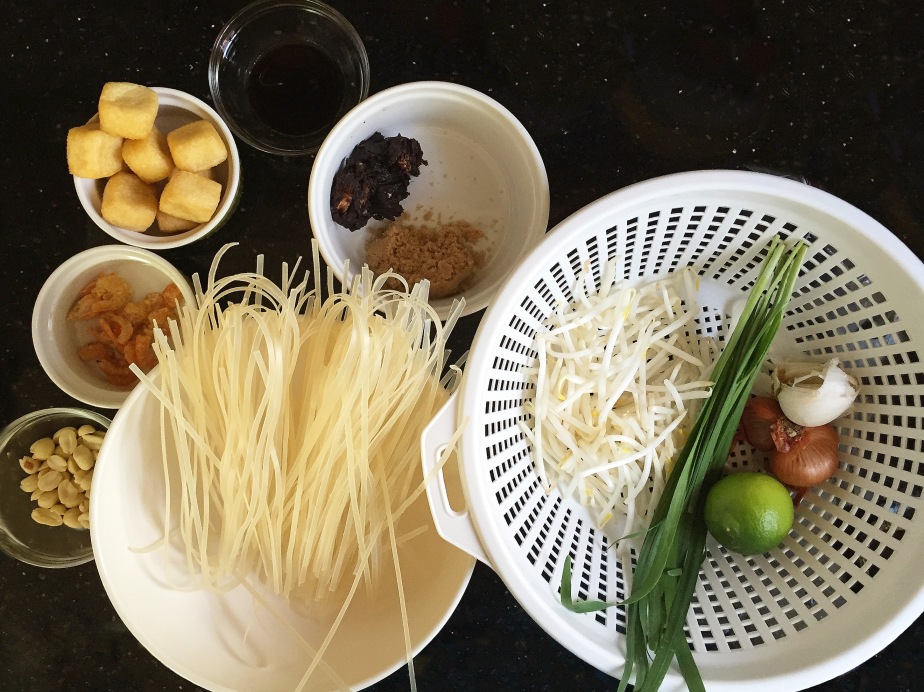
Notes about this recipe! The main ingredient to this recipe is tamarind. It’s a slightly sweet, mainly sour plant that’s used a lot in Southeast Asian cooking. You’ll want to buy this ingredient as “tamarind paste” or “wet tamarind”.


If you can’t find it in your local Asian market, you can order it on Amazon. I wouldn’t skip or substitute this ingredient since it’s a crucial component to the tamarind syrup you’ll make which basically is the base of your entire dish.
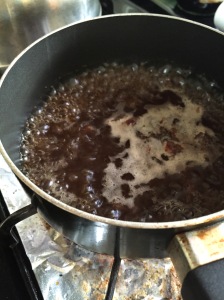
You also need fish sauce in this dish, and while you technically can use salt, fish sauce has that strong umami flavor that you won’t want to skip. If you really need to substitute, I would suggest soy sauce, but try not to substitute if it’s not absolutely necessary since the taste of fish sauce is very unique. Tip: don’t add the fish sauce into your syrup until you’re done with it. I suggest against adding fish sauce right away while the sauce is reducing because (if you didn’t already know this) fish sauce has a pretty strong smell. It’s not necessary to cook the fish sauce with the sauce the entire time, so I’d wait on adding it till the end of the sauce making.
You’ll notice that I use brown sugar instead of white sugar in this recipe. A lot of Thai cooking calls for the use of palm sugar but I realized that most people don’t have palm sugar just lying around in their pantry (unless you’re my mom) so I opted for something more accessible. Brown sugar will create a similar effect, in that it’s a sweetness that has a little more depth than regular white sugar.
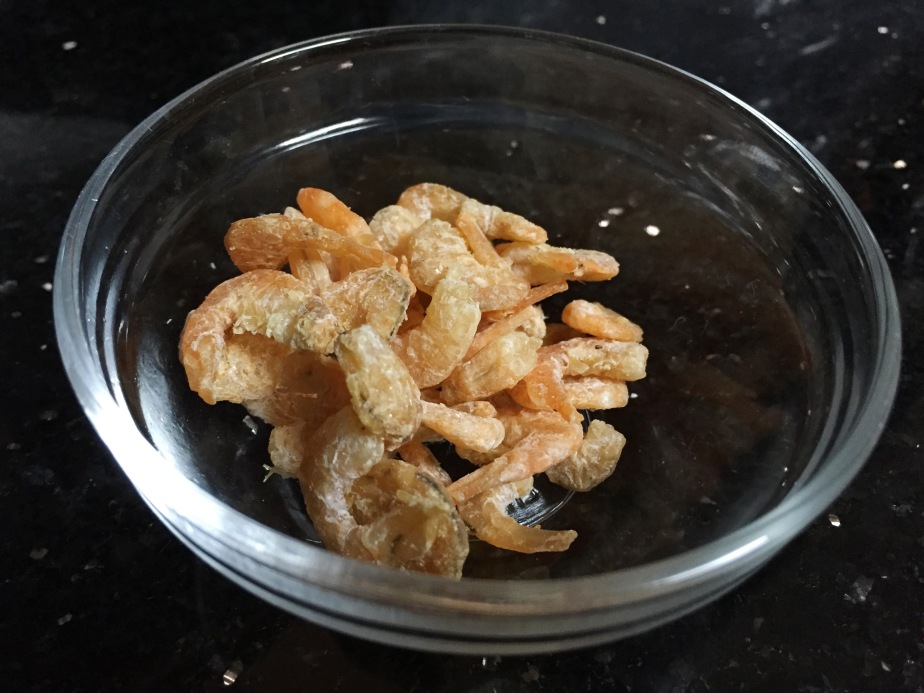
I have dried shrimp listed as an optional ingredient since this isn’t always an easy ingredient to get if you’re not in an area where the markets are stocked with Asian food supplies. I personally like the taste of dried shrimp, and I think they add onto that umami flavor that the fish sauce gives. Not an absolutely necessary in this dish, but it’s nice to have! Make sure to soak them if you use them, otherwise they’ll be really tough.
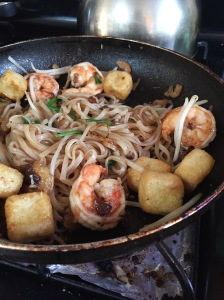 Last thing! When you do this dish, you want a decently high heat (but don’t burn your food!). When you’re making these noodles, you’re not cooking the noodles for a long time since you don’t want your noodles to be soggy. You just want to have the noodles absorb the sauce and mix all your other ingredients in without overcooking anything. Make sure all your ingredients are ready on hand so you can just throw things in when the recipe calls for it. Also, for the bean sprouts, you can throw them all in at once, but I like doing half cooked and half raw since it gives the dish a nicer contrast in textures.
Last thing! When you do this dish, you want a decently high heat (but don’t burn your food!). When you’re making these noodles, you’re not cooking the noodles for a long time since you don’t want your noodles to be soggy. You just want to have the noodles absorb the sauce and mix all your other ingredients in without overcooking anything. Make sure all your ingredients are ready on hand so you can just throw things in when the recipe calls for it. Also, for the bean sprouts, you can throw them all in at once, but I like doing half cooked and half raw since it gives the dish a nicer contrast in textures.
Pad Thai with Shrimp and Tofu

Ingredients
- 1.5 tbsp tamarind paste/wet tamarind
- 2 tsp fish sauce
- 1.5 tbsp of brown sugar
- 1 cup of water
- 4 oz thin dry rice stick noodles (like pho noodles)
- 1.5 tbsp of vegetable oil
- 1 tsp of garlic, minced (~2 small cloves)
- 1 tbsp shallots, sliced (~1 small shallot)
- small bunch of garlic chives, cut into ~2-inch pieces
- 1/2 cup of bean sprouts
- 1 egg
- 4-5 large shrimp, peeled and deveined
- 1/4 tsp of salt
- 1/2 cup of fried tofu (optional)
- 1 tbsp of dried shrimp (optional)
- 1 tbsp of peanuts, toasted and chopped
Directions
- Start by soaking a bunch of things. Soak your rice sticks in warm water until they’re pretty pliable and bendable, which should take about 15-20 minutes. Also, if you’re using them, soak your dried shrimp in warm water as well. Leave these items to soak while you move onto the next step
- Make your tamarind sauce! In a small bowl, mix together the wet tamarind with the brown sugar. You might have to mash the tamarind a bit to get it mixed in well. The sauce should be pretty thin right now. Pour into a small sauce pot and let it simmer until the sauce reduces to half, about 8-10 minutes. Remove from heat and mix in the fish sauce. Set aside.
- Clean your shrimp! After removing the shells and deveining them, rinse them and sprinkle on a 1/4 tsp of salt. Set aside. Side note: you can use the shells for stock later, so feel free to save them in a bag and toss them in the freezer.
- Heat up your oil in a wok on medium high heat. Your oil is ready when shimmers and you’re able to easily swirl it around the pan. Add in the garlic, shallots, and dried shrimp and sauté for about 20 seconds. Don’t discard that water from the dried shrimp!
- Add in your peeled shrimp and sauté for about 2 minutes. They should start to turn that nice orange color.
- Add the tamarind syrup you made earlier into the wok with about 1/4 cup water (which you can use the water used for the dried shrimp from earlier!) and give it a quick stir to combine.
- Add your rice sticks and mix them around. As the noodles soak up the sauce, they’ll start to soften more. Cook for about 2-3 minutes.
- Toss in half of the bean sprouts and chives and mix.
- Move the noodles to the side so you have space to cook your egg. Crack the egg in, scramble it until cooked, and mix it into the noodles. If you find that the noodles are still a little underdone (like if they’re al dente) and there isn’t much sauce left, you can add a little more water.
- Turn off the heat and serve onto a plate with the remaining bean sprouts, chives, and some lime wedges. Sprinkle some chopped toasted peanuts on top of the noodles and enjoy!
Questions? Comments? Stories to share about your first Thai cuisine experience? Leave me a message in the comments 🙂
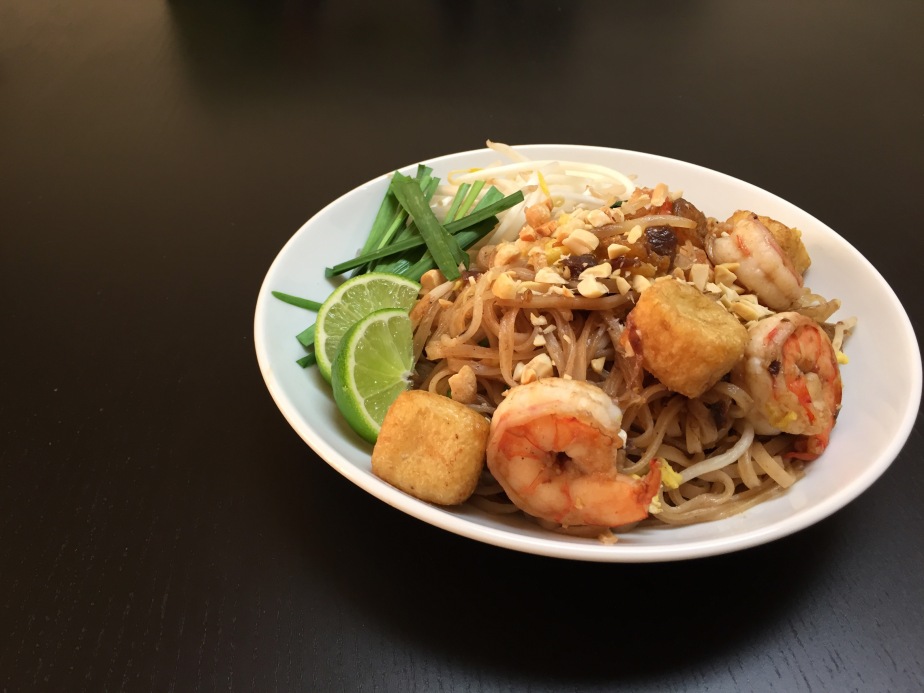
We love Pad Thai. Yummy 🙂
LikeLike